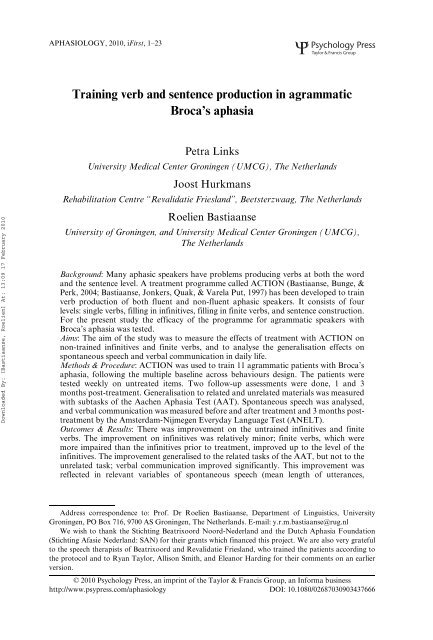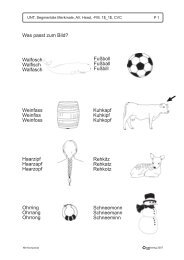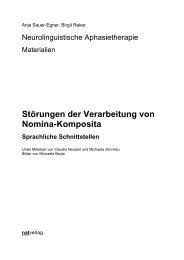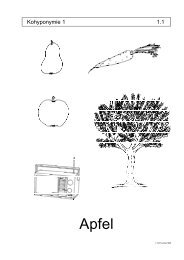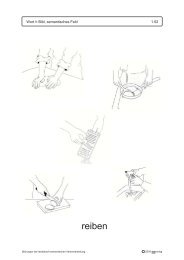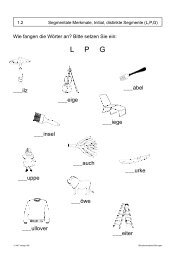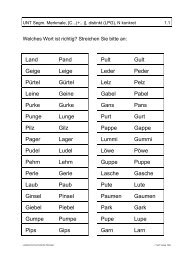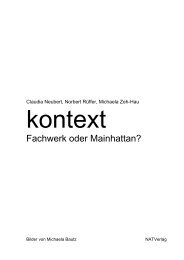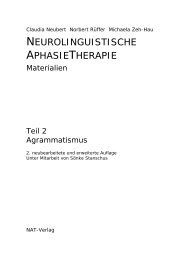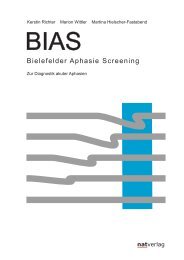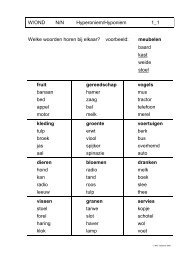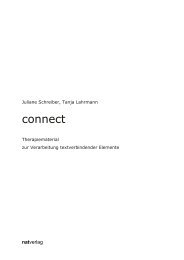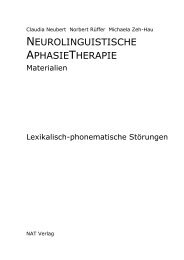Training verb and sentence production in agrammatic Broca's aphasia
Training verb and sentence production in agrammatic Broca's aphasia
Training verb and sentence production in agrammatic Broca's aphasia
Create successful ePaper yourself
Turn your PDF publications into a flip-book with our unique Google optimized e-Paper software.
Downloaded By: [Bastiaanse, Roelien] At: 13:09 17 February 2010<br />
APHASIOLOGY, 2010, iFirst, 1–23<br />
PAPH 0268-7038 1464-5041 APHASIOLOGY, APHASIOLOGY Vol. 1, No. 1, Jan 2010: pp. 0–0<br />
<strong>Tra<strong>in</strong><strong>in</strong>g</strong> L<strong>in</strong>ks, Hurkmans, <strong>verb</strong> <strong>and</strong> <strong>sentence</strong> Bastiaanse <strong>production</strong><br />
<strong>Tra<strong>in</strong><strong>in</strong>g</strong> <strong>verb</strong> <strong>and</strong> <strong>sentence</strong> <strong>production</strong> <strong>in</strong> <strong>agrammatic</strong><br />
Broca’s <strong>aphasia</strong><br />
Petra L<strong>in</strong>ks<br />
University Medical Center Gron<strong>in</strong>gen (UMCG), The Netherl<strong>and</strong>s<br />
Joost Hurkmans<br />
Rehabilitation Centre “Revalidatie Friesl<strong>and</strong>”, Beetsterzwaag, The Netherl<strong>and</strong>s<br />
Roelien Bastiaanse<br />
University of Gron<strong>in</strong>gen, <strong>and</strong> University Medical Center Gron<strong>in</strong>gen (UMCG),<br />
The Netherl<strong>and</strong>s<br />
Background: Many aphasic speakers have problems produc<strong>in</strong>g <strong>verb</strong>s at both the word<br />
<strong>and</strong> the <strong>sentence</strong> level. A treatment programme called ACTION (Bastiaanse, Bunge, &<br />
Perk, 2004; Bastiaanse, Jonkers, Quak, & Varela Put, 1997) has been developed to tra<strong>in</strong><br />
<strong>verb</strong> <strong>production</strong> of both fluent <strong>and</strong> non-fluent aphasic speakers. It consists of four<br />
levels: s<strong>in</strong>gle <strong>verb</strong>s, fill<strong>in</strong>g <strong>in</strong> <strong>in</strong>f<strong>in</strong>itives, fill<strong>in</strong>g <strong>in</strong> f<strong>in</strong>ite <strong>verb</strong>s, <strong>and</strong> <strong>sentence</strong> construction.<br />
For the present study the efficacy of the programme for <strong>agrammatic</strong> speakers with<br />
Broca’s <strong>aphasia</strong> was tested.<br />
Aims: The aim of the study was to measure the effects of treatment with ACTION on<br />
non-tra<strong>in</strong>ed <strong>in</strong>f<strong>in</strong>itives <strong>and</strong> f<strong>in</strong>ite <strong>verb</strong>s, <strong>and</strong> to analyse the generalisation effects on<br />
spontaneous speech <strong>and</strong> <strong>verb</strong>al communication <strong>in</strong> daily life.<br />
Methods & Procedure: ACTION was used to tra<strong>in</strong> 11 <strong>agrammatic</strong> patients with Broca’s<br />
<strong>aphasia</strong>, follow<strong>in</strong>g the multiple basel<strong>in</strong>e across behaviours design. The patients were<br />
tested weekly on untreated items. Two follow-up assessments were done, 1 <strong>and</strong> 3<br />
months post-treatment. Generalisation to related <strong>and</strong> unrelated materials was measured<br />
with subtasks of the Aachen Aphasia Test (AAT). Spontaneous speech was analysed,<br />
<strong>and</strong> <strong>verb</strong>al communication was measured before <strong>and</strong> after treatment <strong>and</strong> 3 months posttreatment<br />
by the Amsterdam-Nijmegen Everyday Language Test (ANELT).<br />
Outcomes & Results: There was improvement on the untra<strong>in</strong>ed <strong>in</strong>f<strong>in</strong>itives <strong>and</strong> f<strong>in</strong>ite<br />
<strong>verb</strong>s. The improvement on <strong>in</strong>f<strong>in</strong>itives was relatively m<strong>in</strong>or; f<strong>in</strong>ite <strong>verb</strong>s, which were<br />
more impaired than the <strong>in</strong>f<strong>in</strong>itives prior to treatment, improved up to the level of the<br />
<strong>in</strong>f<strong>in</strong>itives. The improvement generalised to the related tasks of the AAT, but not to the<br />
unrelated task; <strong>verb</strong>al communication improved significantly. This improvement was<br />
reflected <strong>in</strong> relevant variables of spontaneous speech (mean length of utterances,<br />
Address correspondence to: Prof. Dr Roelien Bastiaanse, Department of L<strong>in</strong>guistics, University<br />
Gron<strong>in</strong>gen, PO Box 716, 9700 AS Gron<strong>in</strong>gen, The Netherl<strong>and</strong>s. E-mail: y.r.m.bastiaanse@rug.nl<br />
We wish to thank the Sticht<strong>in</strong>g Beatrixoord Noord-Nederl<strong>and</strong> <strong>and</strong> the Dutch Aphasia Foundation<br />
(Sticht<strong>in</strong>g Afasie Nederl<strong>and</strong>: SAN) for their grants which f<strong>in</strong>anced this project. We are also very grateful<br />
to the speech therapists of Beatrixoord <strong>and</strong> Revalidatie Friesl<strong>and</strong>, who tra<strong>in</strong>ed the patients accord<strong>in</strong>g to<br />
the protocol <strong>and</strong> to Ryan Taylor, Allison Smith, <strong>and</strong> Eleanor Hard<strong>in</strong>g for their comments on an earlier<br />
version.<br />
© 2010 Psychology Press, an impr<strong>in</strong>t of the Taylor & Francis Group, an Informa bus<strong>in</strong>ess<br />
http://www.psypress.com/aphasiology DOI: 10.1080/02687030903437666
Downloaded By: [Bastiaanse, Roelien] At: 13:09 17 February 2010<br />
2 LINKS, HURKMANS, BASTIAANSE<br />
proportion of f<strong>in</strong>ite <strong>verb</strong>s <strong>and</strong> <strong>verb</strong> diversity), but not <strong>in</strong> an unrelated variable (diversity<br />
of nouns).<br />
Conclusions: Treatment with ACTION resulted <strong>in</strong> better <strong>production</strong> of f<strong>in</strong>ite <strong>verb</strong>s. The<br />
effects generalised to spontaneous speech. Most importantly, it was shown that communication<br />
<strong>in</strong> daily life improved.<br />
Keywords: Aphasia treatment; Verb therapy; Agrammatic <strong>aphasia</strong>; Broca’s <strong>aphasia</strong>;<br />
Recovery.<br />
Agrammatic Broca’s <strong>aphasia</strong> is characterised by telegraphic speech. Although telegraphic<br />
speech was orig<strong>in</strong>ally described as the use of ma<strong>in</strong>ly content words, <strong>and</strong> content<br />
words were def<strong>in</strong>ed as nouns, <strong>verb</strong>s, <strong>and</strong> adjectives, it is now generally<br />
acknowledged that <strong>agrammatic</strong> speakers have severe problems with <strong>verb</strong> <strong>production</strong>.<br />
They use relatively fewer lexical <strong>verb</strong>s (Saffran, Berndt, & Schwartz, 1989; Thompson,<br />
Shapiro, & Schendel, 1994), <strong>and</strong>/or the diversity of the produced lexical <strong>verb</strong>s is<br />
lower than normal (Bastiaanse & Jonkers, 1998). The <strong>verb</strong>s that are produced are<br />
often un<strong>in</strong>flected. These problems with <strong>verb</strong>s are evident <strong>in</strong> spontaneous speech, <strong>and</strong><br />
<strong>in</strong> nam<strong>in</strong>g <strong>and</strong> <strong>sentence</strong> construction tests (see, e.g., Lee & Thompson, 2004, for<br />
English; Bastiaanse, Hugen, Kos, & Van Zonneveld, 2002, for Dutch). Verb problems<br />
<strong>in</strong> <strong>aphasia</strong> are not just restricted to <strong>in</strong>dividuals with <strong>agrammatic</strong> symptoms; fluent<br />
aphasic speakers are often impaired <strong>in</strong> the <strong>production</strong> of lexical <strong>verb</strong>s as well<br />
(Bastiaanse & Edwards, 2004; Berndt, Mitchum, Haendiges, & S<strong>and</strong>son, 1997;<br />
Jonkers & Bastiaanse, 2007).<br />
Data on the effects of <strong>verb</strong> treatment are relatively scarce. In the 1990s several<br />
studies were done to exam<strong>in</strong>e the effects of mapp<strong>in</strong>g therapy, <strong>in</strong> which the <strong>verb</strong> <strong>and</strong><br />
its argument structure play a central role (e.g., Marshall, 1995; Mitchum & Berndt,<br />
1992; Schwartz, Saffran, F<strong>in</strong>k, Myers, & Mart<strong>in</strong>, 1994). More recently, several <strong>verb</strong><br />
treatment studies have been performed, very nicely reviewed by Conroy, Sage, <strong>and</strong><br />
Lambon Ralph (2006). In some of these studies (Pashek, 1998; Wambaugh, Doyle,<br />
Mart<strong>in</strong>ez, & Kal<strong>in</strong>yak-Flishar, 2002) <strong>verb</strong> retrieval was tra<strong>in</strong>ed <strong>in</strong> a similar way to<br />
noun retrieval; that is, by us<strong>in</strong>g phonological, semantic, <strong>and</strong> gestural cue<strong>in</strong>g. The<br />
researchers found improvement on tra<strong>in</strong>ed items, but no generalisation to untra<strong>in</strong>ed<br />
items. Rodriguez, Raymer, <strong>and</strong> Gonzalez Rothi (2006) <strong>and</strong> Rose <strong>and</strong> Sussmilch<br />
(2008) also described the effects of semantic, semantic-phonologic, <strong>and</strong> gesture (plus<br />
<strong>verb</strong>al) treatments on <strong>verb</strong> <strong>production</strong>. Rodriguez et al. (2006) found no generalisation<br />
to untreated <strong>verb</strong>s, <strong>and</strong> modest generalisation was found <strong>in</strong> the study of Rose<br />
<strong>and</strong> Sussmilch (2008).<br />
The other studies reviewed by Conroy et al. (2006) did not just target <strong>verb</strong> nam<strong>in</strong>g<br />
but also exam<strong>in</strong>ed the effect of therapy on <strong>sentence</strong> <strong>production</strong>. Four of them<br />
focused on aspects of <strong>verb</strong> argument structure <strong>and</strong> <strong>sentence</strong> <strong>production</strong> (F<strong>in</strong>k,<br />
Mart<strong>in</strong>, Schwartz, Saffran, & Myers, 1992; Murray & Karchner, 2000; Schneider &<br />
Thompson, 2003; Webster, Morris, & Frankl<strong>in</strong>, 2005). In several of these studies better<br />
<strong>verb</strong> retrieval after tra<strong>in</strong><strong>in</strong>g was reported. In some participants therapy resulted <strong>in</strong><br />
a better <strong>sentence</strong> <strong>production</strong>, but generalisation to untreated <strong>verb</strong>s was not always<br />
found. Remarkably, generalisation to spontaneous speech <strong>and</strong> to <strong>verb</strong>al communication<br />
<strong>in</strong> daily life has been given little attention. Two studies on “constra<strong>in</strong>t-<strong>in</strong>duced<br />
<strong>aphasia</strong> therapy” focused on communicative <strong>and</strong> behaviourally relevant actions<br />
(Pulvermüller & Berthier, 2008) or <strong>verb</strong> <strong>production</strong> (Goral & Kempler, 2009) were


